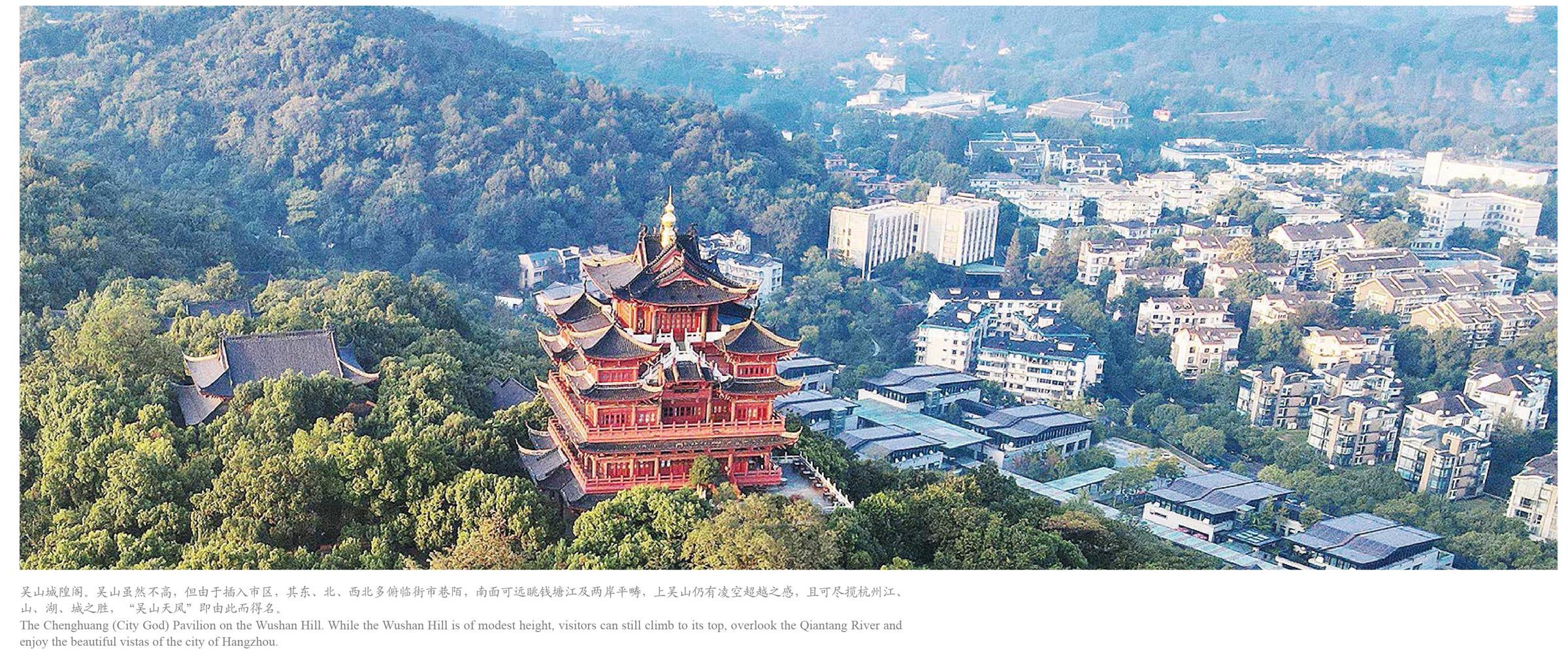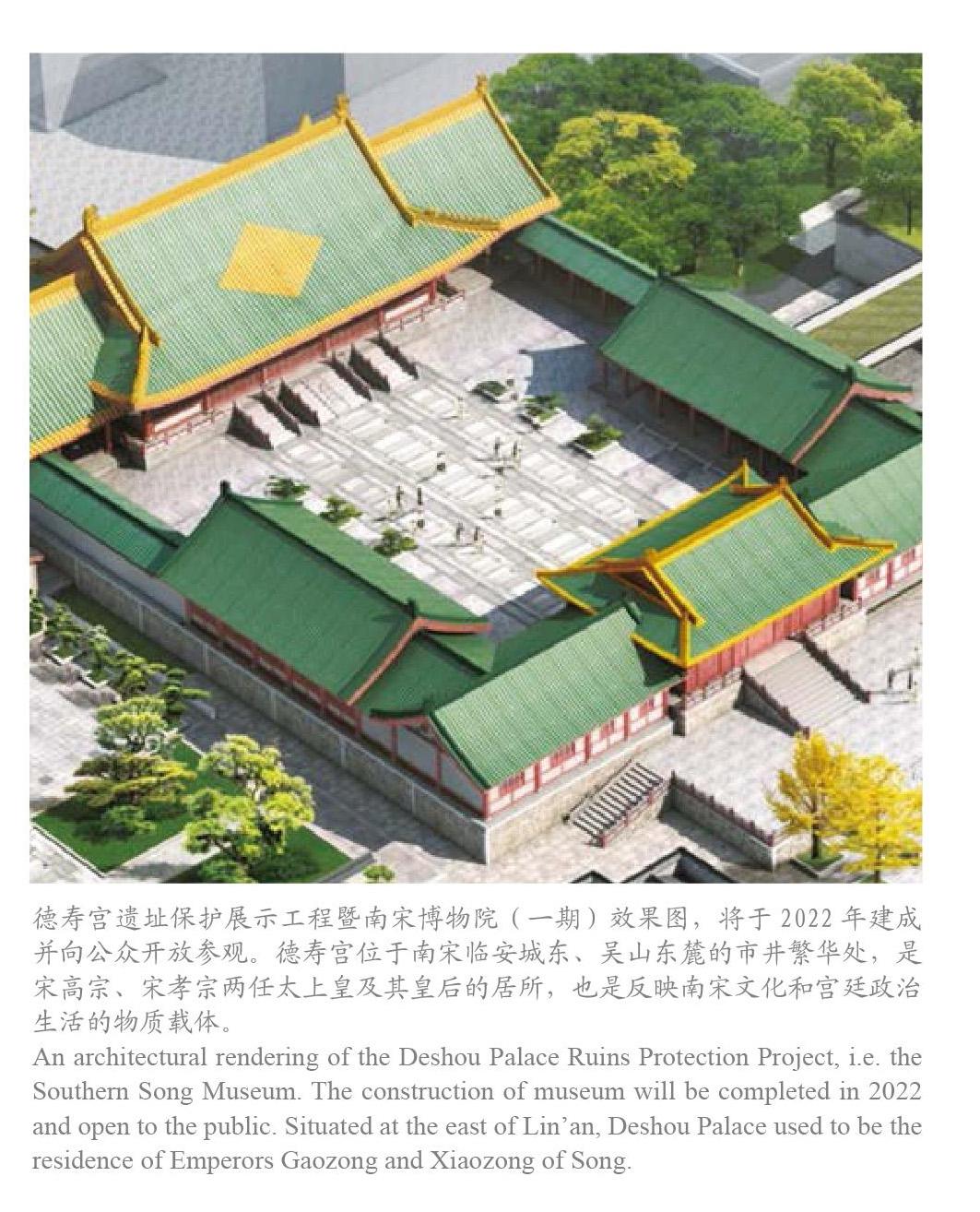江南形胜 南宋梦寻
竺大文 黄慧仙 彭先国



当马可 · 波罗抵达杭州时,这座当时还被称作临安的城市,让见多识广的他也惊叹不已。在那本著名的游记中,他写道:“这座城市的庄严和秀丽,堪为世界其他城市之冠。这里名胜古迹非常之多,使人们想象自己仿佛生活在天堂”。
有一种说法,当时临安仍在南宋的治下,尔后,很快被元军攻占。一场诡异的大火更将皇城化为灰烬。
经历了数个朝代的变迁,数百年的时光淘洗,这段遗落在钱塘江畔的繁华之梦,越发朦胧,似乎已经了无痕迹。
但在记忆深处,南宋皇城作为南宋临安城最重要的遗存,一直是江南人士最重要的“城市印记”。从凤凰山麓的皇城、德寿宫,到紫阳山下的太庙、御街等,南宋皇城都留下了丰富的地下遗存。
对此,杜正贤比起常人有着更深的感悟。他先后主持过南宋太庙遗址、南宋临安府治遗址、老虎洞南宋官窑遗址及恭圣仁烈皇后宅遗址、严官巷南宋御街遗址等的考古挖掘,项目多次入选“全国十大考古新发现”。
数十年光阴,杜正贤与南宋、与临安、与皇城之间积下了深厚的渊源。我们且随他沿着曾经的御街古道,深入凤凰山,一同开始探寻南宋皇城的隐秘。
一方石刻 凤凰山上寻皇城
“山上有一处写着‘皇宫墙的石头,今天不妨先去找找。”杜正贤两手背在身后,脚步轻快,不时绕过铺就的石阶,踏踏林间泥地,颇有一番拜访故友的愉快神色。
我们是由宋城路入凤凰山的。车停在了凤凰山脚下的一处平地上,就此步行上山。杜正贤告诉我们,凤凰山麓这一带堪称杭州的风水宝地,自隋代开始便有文献记载。隋开皇九年(公元589年),废钱唐郡置州,州治初设余杭,故名“杭州”。当时的府治所在就选了这里。
沿山道而行不久,道旁有一方铁皮围栏包裹下的考古工地,正是圣果寺遗址。此寺在文献中常被提及,是确定皇城方位的重要依据。眼前可见数个深浅不一的探方,其间埋藏的有关南宋的传奇与记忆,只能有待考古人员揭晓了。
上行十余步,则见一方巨岩,刻“凤山”二字,高约一米,右题“宋淳熙丁未春”,左题“洛王大通书”。西侧山岩又有西方三佛巨像崩坍后留下的残痕。像极高,约五米,杜正贤说,这些佛像如果仍在,应当是杭州最大的石佛雕像了。
然而,一行人一路已走至半山腰,却仍未见所寻“皇城墙”石刻。杜正贤打了几个电话,又盘桓山间许久,才终于在一处“野径”旁的山石上找到了竖写的“皇宫墙”三字。绿色的青苔衬着红色字体,掩映在幽深的林木间,古意盎然。
“五六年没来,没想到它在此处!”游步道的修建,附近考古工地和树木的变化,让这位老考古人也一时迷失。如此想来,现在距南宋将近千年,要拂去历史的迷雾,更谈何容易。
南宋皇城在凤凰山麓,被多种文献所记录。但其具体范围,仍然在很长一段时间里众说纷纭,莫衷一是。直到近20年,陆续挖掘到四周城墙的地基,才明确了皇城的范围。
“皇城三面环山,北面为万松岭,南城墙以如今的宋城路为界,西侧凤凰山山体作墙,东城墙则紧贴馒头山。北城墙和西城墙采用人工夯筑与自然山体相结合的建造方式,充分利用自然条件构筑皇城防御设施。”杜正贤用几句话为我们勾勒出了南宋皇城的轮廓。
据相关史料记载及考古发现,整个南宋皇城面积约0.6平方公里,仅有北宋开封皇城的二分之一左右。但其布局卻多有独特之处。以皇城选址来说,中国古代都城的营建一般都遵循“坐北朝南”“左祖右社”的布局,即皇宫建在都城的北面,面向南方,以南门为正门,皇宫两侧左边为太庙,右侧为社坛;南宋皇城虽基本承袭了《周礼》“前朝后寝”的传统,却打破了古代皇城“坐北朝南”的布局,兴建“南内”,出现“北内”与“南内”并存的局面;同时,不同于古时都城讲究对称的习惯,南宋皇城并不存在一条纵贯南北的中轴线,形成了南宋临安城“南宫北市”的特殊城市布局,显然有别于一般皇城建筑规制。
杜正贤说,这块“皇城墙”石刻距离真实的城墙其实尚有一段距离,或为后世好事者所书,并无考古价值,以前他也并不在意。但如今他倒觉得,这里提供了一个俯瞰皇城旧址的不错的观测点。
“听说东面山下就是以前的皇城。”当日寂静的空山,许久未闻人声,我们唯一遇见的是一位操着淮北口音的老伯刘师傅,老人的收音机里咿咿呀呀放着戏曲。
循着老人手指的方向,穿透初夏苍翠的山林,跨越数百年的岁月长河,那座早已深埋地下的神秘皇城似又浮现眼前,红墙黛瓦、宫娥青纱穿梭其间……
一座官窑 老虎洞里读宋瓷
但一座皇城并不只是宫殿而已,其间的人物和传说,乃至各种物件,都会给之后的漫长岁月留下更深的刻印。
我们接下来的寻访,则与一种当时内宫里珍贵的器具相遇。那就是让人惊羡的南宋官窑瓷。
1996年,一个偶然机会,杜正贤在杂草丛生的凤凰山东麓山涧溪水旁发现了疑是南宋官窑的瓷片。这里离南宋皇城墙遗址不足百米。
经过3次较大规模的调查和发掘,考古人员在这个被称为“老虎洞”的窑址里共清理出24个瓷片坑,发现了南宋至元代3个时期的遗存,出土一大批完整的和可复原的瓷器和窑具。
宋代官窑由官府直接营建,分北宋官窑和南宋官窑。北宋官窑在北宋末年宋徽宗时才开始烧造,具体的窑址至今没有发现。宋高宗南渡后,在临安(今杭州)另设新窑,“置窑于修内司”。老虎洞的发现,让大多数研究者认定揭开了南宋修内司官窑的神秘面纱。
我们在杭州博物馆见到了几尊泛着青色光泽的老虎洞出土瓷器。
宋代官窑瓷器主要为素面,胎色铁黑、釉色粉青,“紫口铁足”增添古朴典雅之美,官窑的器形除常见的盘、碟、洗等之外,仿商、周、秦、汉古铜器中的各式瓶、炉样式也很多。
老虎洞出土的瓷器多已破碎。“当年应该是因釉色不均而被砸碎的,砸的点八成在瓶口位置。”杜正贤手指一件由碎瓷片拼凑起来的修内司官窑玉壶春瓶说。
古時供给皇室的瓷器要求颇为严格,制成的器物只要略有瑕疵,既无法入贡,又不准流入市面,便只能毁掉。由此却无意间将这些碎片保留给了我们。
从官窑玉壶春瓶到官窑夹层碗、官窑梅瓶……在杜正贤眼里,这里的每件瓷器都有自己的故事,也都映射着南宋独特的审美。经历了唐代消亡、五代战乱,终于安定下来的宋人进入理性思考的时期。
南宋官窑无法复制北宋汝窑的天青色,就转而将粉青色作为最高的标准。这种色调别具一种轻盈、透明、温润的质感。一位研究者曾充满诗意地说,南宋把对北宋的追忆融合在了瓷器上。
宋人更偏爱天然雕饰、返璞归真的极简之美。家具、官窑、书籍都体现了这种审美倾向。虽然已逾近千年,这种风格却越来越唤起现代人的共鸣。
隔三差五,我们会听到宋代器物打破拍卖纪录的消息,故有“家财万贯,不及宋纸一张、宋瓷一片”之说。中国社科院文学所研究员扬之水说,花、香、画、茶、瓷器,当然不是宋人的创造,却是由宋人赋予了雅的品质。
更重要的是,这种审美是沉浸在日常生活里的。饮茶、读书、赏花……并非皇族的专利。因为日常,也流传得更久。
月照何年,花逢几世。皇城已然不再,其地表遗迹仅在万松岭路附近留下一段长约三四十米的北城墙,隐匿于荒草间,但那一方时空的文化艺术韵味却依然回味悠长。
一片街区 市井声中觅余脉
当日,我们下了凤凰山,一路往北,基本上沿着当时的御街行走,幽静感逐渐消失,很快便置身于人声鼎沸的市井之中。
这一带是之前的皇城根,有各部机关,有太庙,现在则可能是杭州保留最完善的老城区。太庙巷、大马弄,一路的小饭馆、药材店、熟食店、猪肉铺。时近中午,附近小区的居民不少驻足在摊位前买菜,来来往往,十分热闹。
“南宋时甚至就有繁华的夜市。”杜正贤说,如今在杭州,像武林夜市、吴山夜市、河坊街夜市等,我们觉得司空见惯,但在宋之前,城市管理非常严格,包括对市场的限制。
比如,唐代长安城市坊格局分明,“坊”是居住区,四周有围墙,有两门或四门供人进出。一般人不准凿墙开设私门,也不准朝着大街开设店铺;“市”是交易区,日中击鼓二百下开市,日落前击钲三百下散市。
到了宋时,临安城里已然废除坊市分割的规制,并允许面向大街开店,与居民混杂毗邻,城市居民“坊郭户”第一次被列入国家法定的户籍管理分类。公元965年,宋太祖把宵禁开始时间推迟到凌晨一点,之后更是完全取消,出现了通宵达旦的夜市。
特别是到了节日,皇城内外更是一片热闹。杜正贤介绍说,南宋宫廷与民间一样,对年节十分重视。逢到元正、立春、元夕、中和、重九这些重要的节日,都有一整套的仪式。
元日、冬至两日要举行大朝会的仪式,称之为“元正”。皇帝先到福宁殿及圣堂上焚香,接着到天章阁祖宗神殿,行酌献礼。然后回到福宁殿,接受皇后、太子、皇子等拜贺。完毕后,到大庆殿御史台阁门,接受文武百僚们祝贺,奏太常雅乐,群臣十六拜,致辞上寿,枢密官代表皇上致答辞,赐酒宴,放鞭炮。午后,则要备办晚宴,并放烟火,赏灯。
“但南宋也有简朴的一面,皇城考古这么多年,我在这里没见过一片琉璃瓦。”杜正贤感叹说。这些可能与匆忙定都有关,皇室难有大兴土木之力,对于都城的建设采取“能省则省”的务实态度。
A Glimpse of Linan, an Ancient Imperial City
of the Southern Song Dynasty
By Zhu Dawen Huang Huixian Peng Xianguo
When Marco Polo arrived in Hangzhou (then known as Linan), well traveled as the man was, he was filled with amazement.
It is said that at that time Linan was still under the reign of South Song dynasty (1127-1279), and before long it would be invaded and occupied by the Yuan (1271-1368) troops. Later it was burned to ashes by a big fire, the source of which was unable to identify.
After hundreds of years where dynasties frequently changed, now Linan, a once dream-like city at the Yangtze river, is being forgotten gradually, although it had its days of unparalleled prosperity.
For Linan, the Imperial City is the most important remains of the Southern Song dynasty. And it left a rich underground cultural heritage, from the Imperial City and Deshou Palace at the foot of the Phoenix Mountain to the Imperial Temple and the Imperial Street under the Ziyang Mountain.
When it comes to this, Du Zhengxian has his own thoughts. He has presided over several archaeological excavation projects related to the Southern Song dynasty remains, and his projects have been frequently featured in the “Top Ten New Archaeological Discoveries in China”.
Now, lets follow him along the ancient road of the Imperial Street, and deep into the Phoenix Mountain, to explore the untold stories of the Southern Song Imperial City.
“There is a stone on the hill that says ‘Palace Wall, so we might want to go and find it for starters,” said Du, putting both hands behind his back and walking briskly, as if he was pleasantly on the way to meeting an old friend.
We entered the Phoenix Mountain from the Songcheng Road. After parking our car on a flat area at the foot of the Phoenix Mountain, we walked up the mountain. Du told us that this area is highly treasured in Hangzhou, because of its good fengshui, which has been documented since the Sui dynasty (581-618). In the year 589, Qiantang was abolished as a county (jun) and then set up as a prefecture (zhou), with Yuhang serving as the government seat, hence the name “Hangzhou”.
Shortly after walking along the mountain road, there is an archaeological site wrapped in iron fencing next to the road, which is the remains of the Sacred Fruit Temple. This temple is often mentioned in the literature as an important basis for determining where the imperial city was.
Going up for a dozen steps, a huge rock with various engraving could be seen. On the west side of the rock, there are remnants of the collapsed statue of the Three Western Buddha. The statue was believed to be extremely high, about five meters. If these Buddha statues were still in existence, they would have been the largest stone Buddha statue in Hangzhou, according to DU.
However, although we had reached the halfway point of the mountain, the “Palace Wall” stone carving was still nowhere in sight. It was only after Du made several phone calls and hovered around for some time that the words “Palace Wall” were finally found written vertically on the rock next to one that says “Wilderness Path”.
“I havent visited this place since five or six years ago, and here it is!” All the changes have well confused even this experienced archaeologist. If you think about it—nearly a thousand years have passed since the Southern Song dynasty, and it is never easy to see through the mist of history.
The Southern Song Imperial City at the foot of the Phoenix Mountain has been recorded in various documents. However, the specific scope of the Imperial City has been unclear for quite a long time. In the past two decades, it has finally been clarified because the foundations of the surrounding walls have been discovered during continuous excavations.
“The Imperial City is surrounded by mountains on three sides: the north is the Wansong Hill; the south wall is bounded by Songcheng Road; the west is the Phoenix Mountain; the east is close to the Mantou Mountain. The northern and western walls were built by artificial construction while relying on natural hills, and the whole defense system was also created by making full use of the nature.” Du shortly sketched out the outline of the Imperial City for us.
According to relevant historical records and archaeological findings, the entire Southern Song Imperial City in Linan covers an area of about 0.6 square kilometers, only half the size of the Northern Song Dynasty Imperial City in Kaifeng. However, its layout has many unique features. For instance, in Linan, the palace stands in the south of the city while the markets in the north, quite the opposite from traditions.
“Although this ‘Palace Wall stone carving is far from the real walls back then,” said Du, “it is a good observation point overlooking the old Imperial City.”
But an imperial city is not just a palace; it is more about the people, the legends, and the objects. Our next visit was to see the amazing Southern Song official kiln porcelains.
In 1996, Du Zhengxian happened to find a porcelain tile, which looked like an object from one of the Southern Song official kilns. It was discovered beside a stream at the eastern foot of the Phoenix Mountain, less than 100 meters from the site of the Imperial City wall.
After three large-scale investigations and excavations, archaeologists cleared a total of 24 porcelain tile pits at the site, known as the “Tigers Cave”, and discovered the remains of three periods from the Southern Song dynasty to the Yuan dynasty, unearthing a large number of complete and recoverable porcelains.
In Dus eyes, each piece of the porcelains here has its own story and maps the unique aesthetics of the Southern Song dynasty. From those porcelains, we could easily figure out that the Song people preferred the natural and minimalist beauty, and this century-old aesthetic taste is increasingly resonating with modern people.
Later, we descended the Phoenix Mountain and made our way north, generally walking along what was then the Imperial Street, where the sense of seclusion gradually disappeared and we were soon in the middle of the bustling city.
This area was the root of the former Imperial City, with its various ministries and temples, and now is probably the best preserved old town in Hangzhou. “There were even prosperous night markets in the Southern Song dynasty,” explained Du.
Walking along the street, we are deeply impressed, for the soul of the Song Dynasty not only survives in poems, books and songs, but also flows in the ordinary lanes and streets. Even the authentic Hangzhou dialect, which drifted into our ears from time to time in this neighborhood, is speaking the changes of the Southern Song dynasty.
That being said, whether it is the Taimiao Ruins Park and the Southern Song Dynasty Ruins Exhibition Hall on South Zhongshan Road, the Cultural and Creative Park at the foot of Phoenix Mountain Road, or even a random store on the roadside, all of them are marked by history and are connected with time and space in their own way.
Sacred Fruit Temple Site
It is located in the west of the Broom Bay between the Jiangtai Mountain and the Phoenix Mountain in Shangcheng district, Hangzhou. The Sacred Fruit Temple was built in the second year of Emperor Wen of the Sui Dynasty (582). A number of historical sites lie around the place.
Southern Song Dynasty Imperial Temple Site
Located in Ziyang Street, it was built during the reign of Emperor Gaozong of the Song Dynasty and was second in scale and form only to the inner Imperial Palace.
Deshou Palace Ruins
Located on the north side of Wangjiang Road in Shangcheng district, Hangzhou, it was once the old residence of Qin Hui (1090-1155), before Emperor Gaozong of Song dynasty took it back and built a new palace.
North Wall Site of Southern Song Dynasty Imperial City
Located in the south of Wansongling Road and west of the citys Chinese herbal medicine warehouse, it is one of the few surviving above-ground sites of the Southern Song Dynasty Imperial City.
Tigers Cave, the Southern Song Dynasty Official Kiln Site
It is located in a long and narrow ravine between the Phoenix Mountain and the Jiuhua Mountain in Shangcheng district, Hangzhou. The excavators believe that the Southern Song layer of this site is the “Southern Song Xiuneisi Official Kiln”, as documented in historical records.

